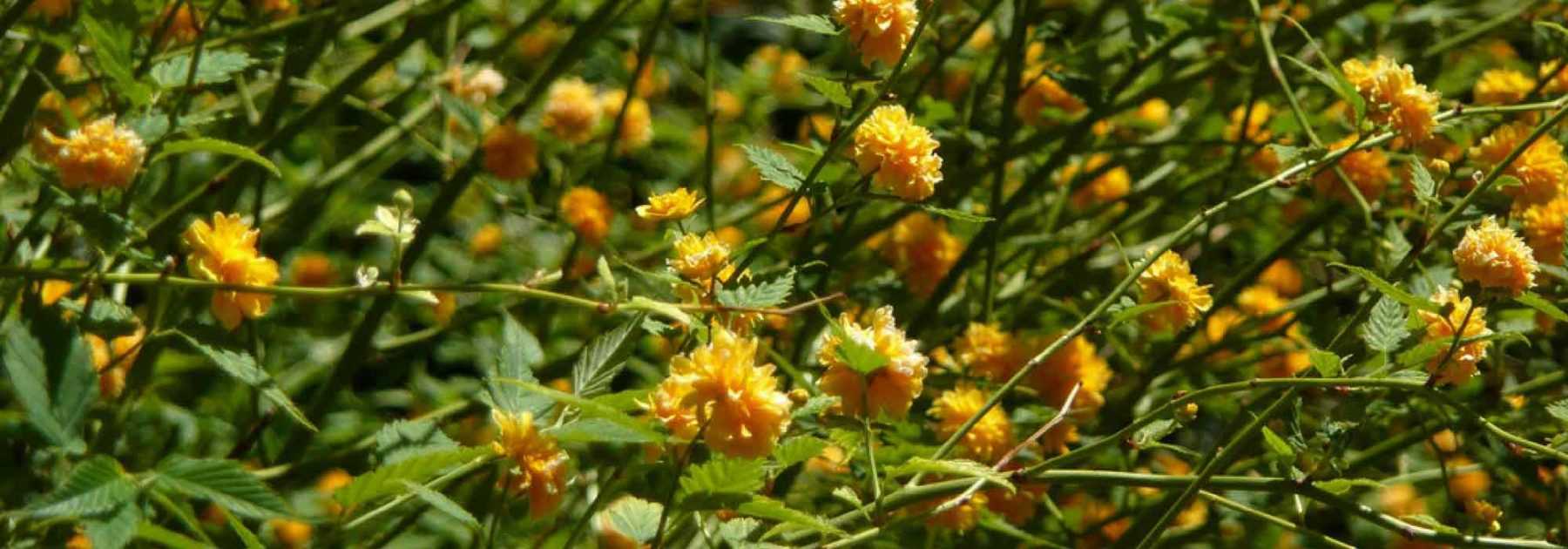
Japanese Kerria, Kerria japonica: Planting, Pruning and Care
Contents
The Japanese Kerria, in a few words
- The Japanese Corête offers a generous spring flowering with yellow pom-pom shaped blooms
- This beautiful shrub brings sunshine to the garden and is equally decorative for its delicate foliage
- It thrives easily in full sun or partial shade
- Compact and very hardy, it adapts well to all garden settings
- Perfect for informal hedges, mixed borders and container growing
Our expert's word
The Kerria or Japanese Rose is a shrub commonly found in our gardens, notably hardy and exceptionally floriferous with the arrival of spring. From April to May, its bright green foliage becomes covered in a golden shower of small pompon-like flowers that will catch everyone’s eye.
Its lovely bushy shape and moderate size make it versatile for all types of gardens, even small ones, from the most naturalistic to the wildest.
Today, you can find some interesting cultivars, including the must-have Kerria Japonica ‘Pleniflora’. However, despite hybridisation efforts, there is still no pink-flowered Japanese Rose—this shrub remains steadfastly yellow!
It spreads so easily by suckering that some may find the Japanese Rose slightly invasive… But the vigour of this beautiful shrub is matched only by its prolific flowering and hardiness in all conditions!
Whether planted as a standalone specimen, in a flowering hedge, in a container, or within a mixed border, this extremely hardy shrub (down to -25°C) will reveal its splendour in the heart of spring. Tough, disease-resistant, and very easy to grow, the Japanese Rose thrives in sun or partial shade and grows anywhere in fresh, fertile, well-drained soil, sheltered from wind.
With its dazzling blooms, light and elegant summer foliage, and stems that stay vibrant green even after leaf drop, this is a radiant ornamental shrub for all seasons.
Hardy, compact, and highly tolerant of urban pollution, discover how to take cuttings from the Japanese Rose or when to prune this essential spring-flowering shrub.
Description and botany
Botanical data
- Latin name Kerria japonica
- Family Rosaceae
- Common name Japanese Kerria
- Flowering d'avril à juin
- Height 1,50 à 3 m
- Exposure Soleil, mi-ombre
- Soil type Neutre, acide, bien drainé
- Hardiness -25°
The Kerria or Japanese Kerria is a flowering shrub, the sole species in the Kerria genus. Belonging to the large Rosaceae family, it grows in open woodlands and thickets of China and Japan where it later naturalised.
The original species Kerria japonica, which is hardly cultivated anymore, gave rise to some interesting cultivars including ‘Pleniflora’ which is the most widespread, ‘Golden Guinea’ or ‘Picta’.
Fast-growing, the Kerria quickly forms an elegant bush with few branches, an upright, somewhat unruly habit, with arching stems that remain bright green, tending to spread with age and under the weight of flowers. It rarely exceeds 2 to 3 metres in height with a spread of 2.50m.
The Japanese Kerria establishes easily by suckering along the ground; at best this will give the shrub a beautiful ground cover at maturity, at worst it may become somewhat invasive. With average longevity, it typically lives 10 to 15 years.
The Kerria boasts one of the most beautiful spring blooms. From April to June, a profusion of numerous small golden-yellow flowers 2 to 6 cm in diameter, cover the shrub in a golden shower. They appear singly along the flexible green stems. While the original species and most varieties like ‘Golden Guinea’ have large single flowers resembling small lemon-yellow roses, Kerria japonica ‘Pleniflora’ bears double flowers, resembling silky orange pompons. This flowering may modestly repeat in late summer.
In vases, cut stems covered with flowers make fresh and cheerful bouquets.
This beautiful, particularly floriferous shrub is also decorative for its light foliage which serves as a setting for this dazzling yellow flowering. At the same time as the flowers, deciduous leaves 6 to 10 cm long appear. Oval in shape, they are alternate, simple, finely toothed and taper to a pointed tip. Bright green to soft green, sometimes grey-green, they are sometimes edged with creamy white, depending on the variety.
After leaf fall, the shrub whose stems remain bright green all winter, retains some ornamental interest.
Hardy down to -25°C, particularly resistant to pollution, the Japanese Kerria is easy to grow. Undemanding, it thrives in all climates, in full sun or light shade, in any soil even chalky or slightly acidic, rich, moist, light and well-drained.
With its bushy silhouette, modest size and bright flowering, the Japanese Kerria finds its place in all gardens, whether large or small. It works wonders in informal hedges or shrub borders or as a standalone specimen. It performs very well in pots and also makes a beautiful espalier against walls.
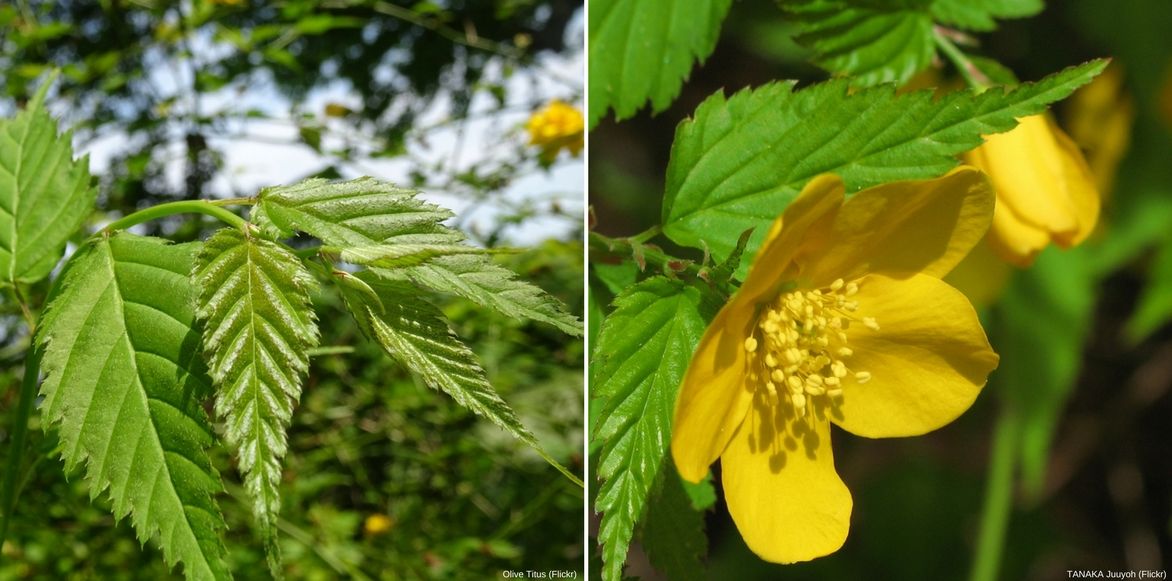

From left to right: light, finely toothed foliage / single flower of a Kerria japonica ‘Golden Guinea’.
Main species and varieties
The genus includes only one species, Kerria japonica, which is rarely cultivated anymore. It has given rise to several interesting cultivars, widely popular in our gardens, such as ‘Pleniflora’ with its double flowers forming lovely orange pompons, ‘Golden Guinea’ with large single flowers in golden yellow, or ‘Picta’ with grey-green foliage variegated with cream. All are very hardy, easy to grow, and form a beautiful, exceptionally floriferous shrub.
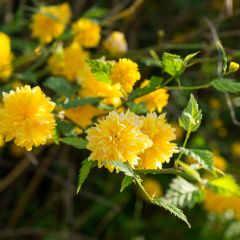
Kerria japonica Pleniflora - Japanese Rose
- Flowering time May, June
- Height at maturity 2 m
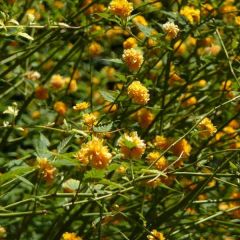
Kerria Japonica Pleniflora en pochette
- Flowering time May, June
- Height at maturity 2 m
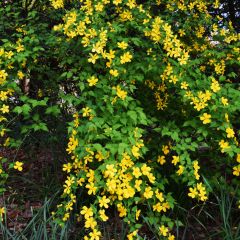
Kerria japonica Golden Guinea - Japanese Rose
- Flowering time May, June
- Height at maturity 2 m
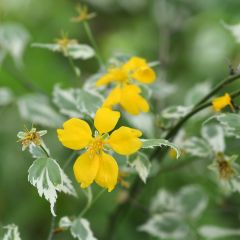
Kerria japonica Picta - Japanese Rose
- Flowering time May, June
- Height at maturity 1,50 m
Discover other Kerrias
Planting
Where to plant Japanese Kerria
Japanese Kerria grows throughout France, except perhaps in Mediterranean climates, which can be too hot and dry in summer. Remarkably hardy, it can withstand very low temperatures down to -25°C, sometimes even lower, making it perfectly resilient in all regions.
It should preferably be planted sheltered from strong winds to protect its arching stems, especially when they bend under the weight of the flowers.
It prefers sunny spots where it flowers best, though it tolerates partial shade, particularly in warmer regions. Too much shade may result in a slightly less abundant bloom.
Undemanding, it thrives in well-drained, humus-rich soil that remains moist in summer: avoid overly dry soils or waterlogged ground in winter.
Kerria japonica is a compact shrub that adapts to all gardens. It pairs well with other fast-growing plants to create an instant garden; it quickly forms a beautiful bush of greenery, rarely exceeding 2.50m in height and nearly as much in width.
However, ensure it has enough space: it spreads vigorously through suckers, sometimes overwhelming neighbouring plants.
Its tolerance to urban pollution makes it indispensable in city gardens. It works well in free-flowering hedges, as a backdrop to perennial beds, or in a cluster of spring-flowering shrubs, trained against a wall or trellis, as a standalone feature on a lawn, or even in a large pot on a sunny but not scorching terrace.
When to plant
Kerria japonica is best planted in autumn from November to February to encourage root establishment before winter, avoiding frosty periods. Potted specimens can also be planted in spring, provided they receive regular watering during their first year.
How to plant
In the ground
Japanese Kerria prefers fertile, well-draining soil where water does not stagnate, especially in winter.
For hedges, space plants about 80cm apart.
- Soak the root ball in a bucket of water
- Dig a hole twice as wide and deep as the root ball
- Enrich the excavated soil with half a bucket of well-rotted compost
- Plant the shrub in the centre of the hole
- Backfill, keeping the shrub upright, and firm the soil
- Mulch to keep the base clean and cool in summer
- Water lightly after planting, then once or twice weekly during the first growing season
- Japanese Kerria in pots
Japanese Kerria can be grown in pots, provided the container is large enough (at least 90cm in diameter). The substrate must be well-draining to avoid waterlogging at the roots. Repot every 2–3 years.
- Add a thick layer of drainage (gravel or clay pebbles)
- Plant in quality shrub compost mixed with one or two spadefuls of compost
- Mulch the base
- Water well during the growing season, then when the soil dries out
Care and Maintenance
The Japanese kerria requires very minimal maintenance. It prefers cool, not overly dry soils. In summer, water once or twice a week during heatwaves. To keep the base cool during the growing season, apply a good organic mulch before spring, especially in the first few years after planting.
Regularly remove the numerous suckers that appear around the base of the plant.
For potted kerrias: keep the growing medium consistently moist.
An annual application of compost at the base in autumn improves growth and enhances flowering.
How and When to Prune Japanese Kerria?
When to Prune Japanese Kerria?
Pruning should be carried out annually, after flowering, in June. Trimming helps to thin out the branches to prevent an overly bushy appearance, tame its growth and maintain a compact shape, encourage vigorous regrowth and ensure abundant, regular flowering: over time, the shrub tends to become bare in the centre and only flowers at the tips. Depending on how it’s pruned, you may see modest reblooming in late summer and autumn.
How to Prune?
- Cut back approximately one-third of the current year’s flowered stems to just above a strong bud at the base of the stem.
- Remove old wood, dead stems, weak or tangled growth at ground level, ensuring light can penetrate the centre of the shrub.
→ Learn more in our tutorial: How to Prune Japanese Kerria?
Diseases and potential pests
Japanese Kerria is generally not prone to diseases or pest attacks.
However, a report submitted to the Royal Horticultural Society in 2014 noted that some British gardeners had observed damage in the form of reddish-brown spots, stem lesions, and defoliation that could lead to the shrub’s death. According to sample analysis, this infection was caused by a specific fungus, Blumeriella kerriae, whose spread is encouraged by damp weather conditions.
We recommend cutting away all affected plant material and burning it to kill fungal spores. The fungus overwinters in fallen leaves and stem lesions. Be sure to also gather and dispose of dead leaves to reduce inoculum levels the following year.
Propagation
By dividing suckers
The Japanese Kerria naturally produces suckers: it can be easily propagated by separating the young rooted suckers growing at the edge of the clump. They will flower the following spring.
- In October, use a spade to lift a clump of soil with rhizomes and roots, then remove several suckers
- Replant the rhizome divisions immediately in well-worked, light garden soil
How to take root cuttings from Kerria japonica
- In autumn or winter after flowering, collect surface roots that have buds
- Cut the roots into 4 to 10 cm sections, each with one or more buds
- Place clay pebbles at the bottom of a tray filled with a light potting mix
- Plant the cuttings and cover with 2 cm of compost
- Place the tray in an unheated room
- Transplant into the ground once the cuttings are well-rooted
Pairing Kerria japonica
Queen of the spring scene, the Japanese Kerria is remarkable for its profusion of golden-yellow flowers in spring. Compact and easy-going, it has a place in every natural and wild garden. Whether planted as a standalone feature against a wall or on a lawn, in borders or informal hedges, it pairs beautifully with a multitude of plants, bulbs and other spring-flowering shrubs for wonderfully vibrant monochrome displays, chic bucolic schemes in white and gold, or striking gold/blue contrasts.
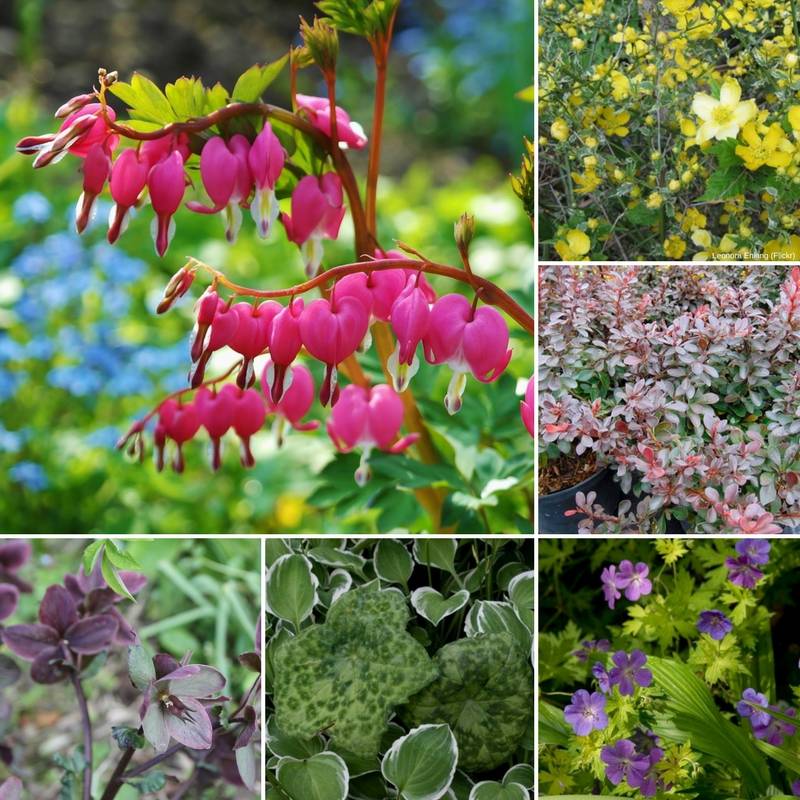

A spring planting idea: Dicentra spectabilis, Kerria japonica ‘Picta’, Berberis thunbergii ‘Atropurpurea Nana’, faded yet still decorative flowers of Helleborus orientalis, Podophyllym ‘Spotty Dotty’ and Hosta ‘Silver Crown’, Geranium ‘Blue Sunrise’.
Its sunny blooms will accompany the simultaneous flowering of Forsythias, brooms, the golden rain of Laburnum ‘Vossii’, or the canary-yellow blooms of Magnolia ‘Daphne’. It can be paired with plants bearing mauve or bluish flowers like lilacs, rose of Sharon, buddleias, blue hydrangeas or abelias, creating elegant contrasts with its yellow flowers.
The Japanese Kerria also pairs beautifully with tall delphiniums which share similar growing conditions.
In an informal flowering hedge, it makes the perfect companion for shrubs that flower earlier or later in the season, extending the display – think flowering currants, spirea, deutzia, and weigela.
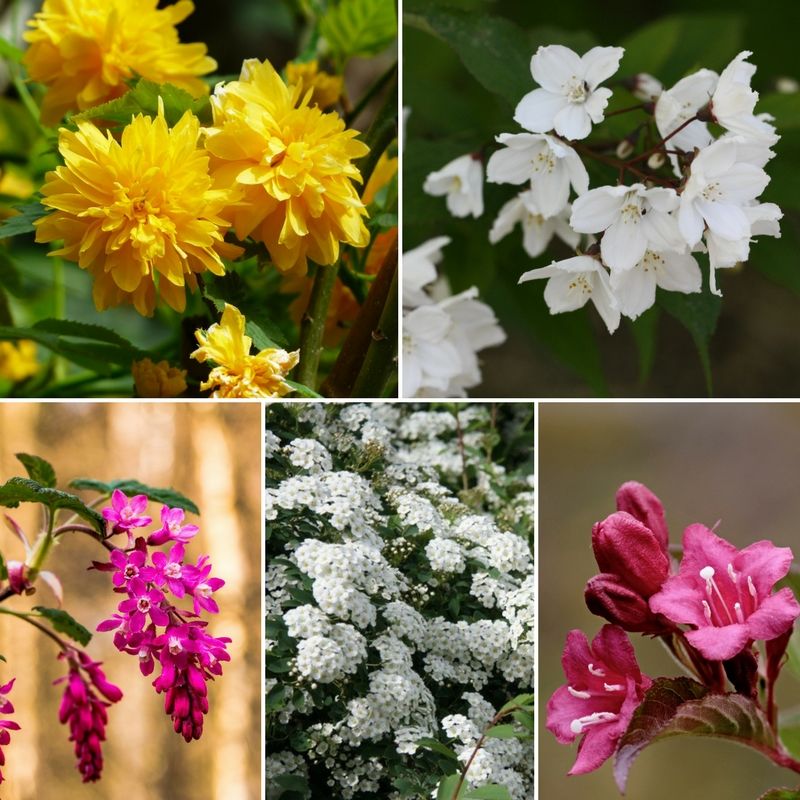

An example of an informal hedge combination: Kerria japonica ‘Pleniflora’, Deutzia rosea ‘Campanulata’, Ribes sanguineum ‘King Edward VII’, Spirea nipponica ‘Snowmound’, Weigelia ‘Bristol Ruby’.
In borders, pair it with shrubs featuring decorative foliage to maintain garden interest after flowering – like Elaeagnus ebbingei ‘Eleador’ with its stunning variegated leaves or Kolkwitzia amabilis Maradco (Beauty Bush) with its bright yellow foliage.
Dare to combine it with a Malus ‘Golden Hornet’, Choisya ternata, Viburnum plicatum and Symphytum for a striking contrast of forms.
Its golden-yellow flower-covered branches will provide a backdrop for early-flowering euphorbias and bulbs like yellow daffodils, fritillaries, steppe lilies or tulips, creating vibrant compositions that bring cheer and brightness to the garden.
After leaf fall, its gracefully arching green stems make a striking winter feature alongside Cornus stolonifera ‘Flaviramea’ with its vivid yellow winter stems, adding colour when most plants are dormant.
→ Discover more planting ideas with Kerria japonica in our advice sheet!
Useful resources
- The most beautiful Kerrias are here with us!
- Discover 7 yellow-flowering shrubs
Frequently asked questions
-
My Japanese Maple is drying up, what's happening?
Like all trees and shrubs in the Rosaceae family, the Kerria can be particularly susceptible to fire blight in certain regions: affected leaves, flower clusters, and shoots appear scorched, the shrub dries up suddenly and dies within weeks. There is no truly effective treatment. For prevention: in March-April, spray a horsetail decoction. If infected: first remove and burn any spotted leaves and affected shoots. Uproot and burn the plant if the disease is too widespread.
- Subscribe!
- Contents




































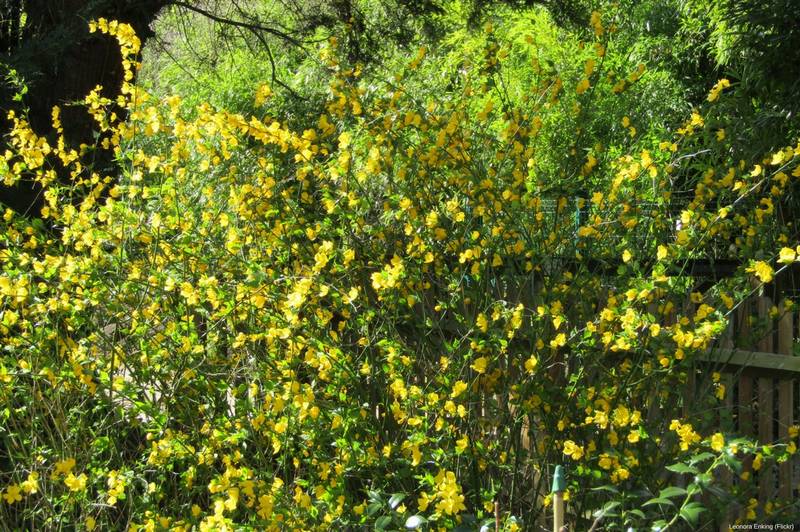
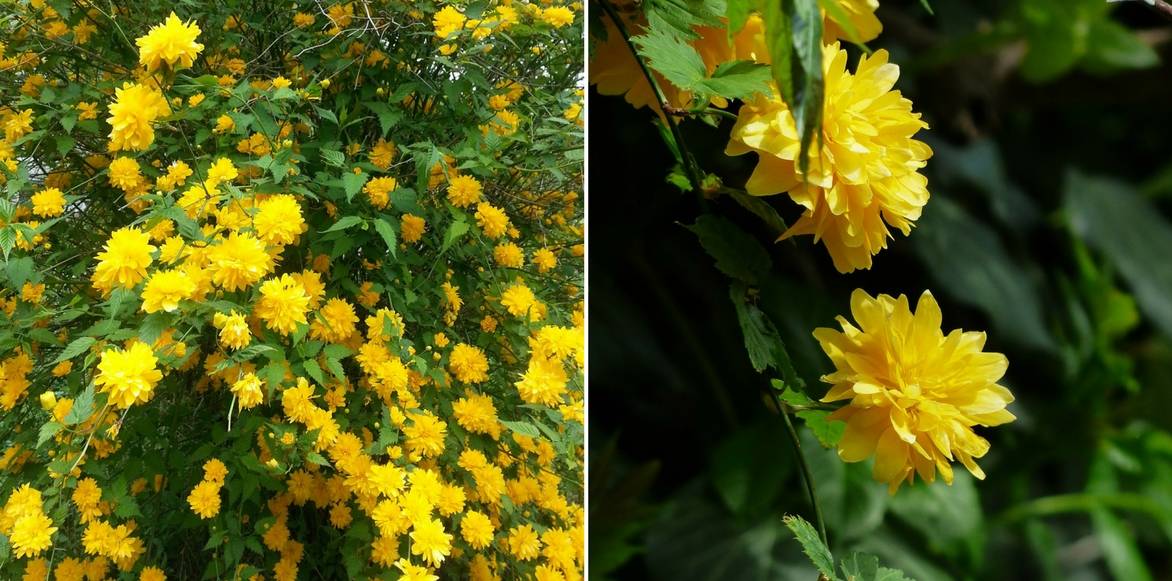
Comments